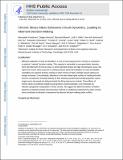Chronic Stress Alters Striosome-Circuit Dynamics, Leading to Aberrant Decision-Making
Author(s)
Friedman, Alexander; Homma, Daigo; Bloem, Bernard; Gibb, Leif G.; Amemori, Ken-ichi; Hu, Dan; Delcasso, Sebastien; Truong, Timothy F.; Yang, Joyce C; Hood, Adam S.; Mikofalvy, Katrina A.; Beck, Dirk W.; Nguyen, Norah; Nelson, Erik; Toro Arana, Sebastian; Vorder Bruegge, Ruth H.; Goosens, Ki Ann; Graybiel, Ann M; ... Show more Show less
DownloadAccepted version (4.831Mb)
Terms of use
Metadata
Show full item recordAbstract
Effective evaluation of costs and benefits is a core survival capacity that in humans is considered as optimal, “rational” decision-making. This capacity is vulnerable in neuropsychiatric disorders and in the aftermath of chronic stress, in which aberrant choices and high-risk behaviors occur. We report that chronic stress exposure in rodents produces abnormal evaluation of costs and benefits resembling non-optimal decision-making in which choices of high-cost/high-reward options are sharply increased. Concomitantly, alterations in the task-related spike activity of medial prefrontal neurons correspond with increased activity of their striosome-predominant striatal projection neuron targets and with decreased and delayed striatal fast-firing interneuron activity. These effects of chronic stress on prefronto-striatal circuit dynamics could be blocked or be mimicked by selective optogenetic manipulation of these circuits. We suggest that altered excitation-inhibition dynamics of striosome-based circuit function could be an underlying mechanism by which chronic stress contributes to disorders characterized by aberrant decision-making under conflict.
Date issued
2017-11Department
McGovern Institute for Brain Research at MIT; Massachusetts Institute of Technology. Department of Brain and Cognitive SciencesJournal
Cell
Publisher
Elsevier BV
Citation
Friedman, Alexander et al. "Chronic Stress Alters Striosome-Circuit Dynamics, Leading to Aberrant Decision-Making." Cell 171, 5 (November 2017): P1191-1205.e28 © 2017 Elsevier
Version: Author's final manuscript
ISSN
0092-8674